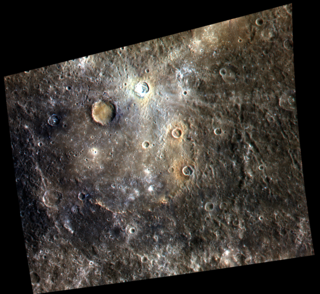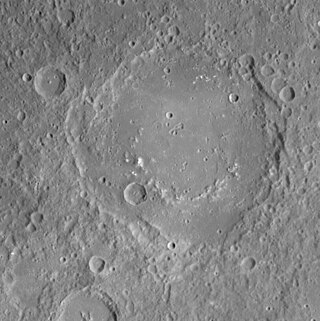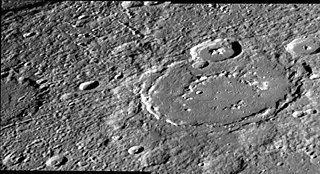
Vivaldi is a crater on Mercury. It was named by the IAU after Italian composer Antonio Vivaldi in 1976. It has a prominent and nearly continuous inner ring whose diameter measures about half that of the outer ring. It is one of 110 peak ring basins on Mercury. Unlike some of the lunar multiringed structures, no vestiges of additional rings are apparent around this crater. It is classified as c3 age.

Mozart is a crater on Mercury, named by the IAU in 1976 after Austrian composer Wolfgang Amadeus Mozart.

Homer is a crater on Mercury. It is one of 110 peak ring basins on Mercury.

Praxiteles is a crater on Mercury. It is one of 110 peak ring basins on Mercury.

Moody is an impact crater on Mercury.

Amaral is a crater on the planet Mercury. With its smooth floor, surrounding ejecta, and small secondary craters, it appears noticeably younger than the heavily cratered surface around it. Along with a smooth crater floor, Amaral also has a central peak. Bright material on this peak is of particular interest as it appears to have an unusual color. In color-enhanced images, the central peak of Amaral appears as a bright blue color in striking contrast to the otherwise orange tones of surface material nearby. The different color of the central peak likely indicates rocks with different chemical composition from those on the neighboring surface.

Raditladi is a large impact crater on Mercury with a diameter of 263 km. Inside its peak ring there is a system of concentric extensional troughs (graben), which are rare surface features on Mercury. The floor of Raditladi is partially covered by relatively light smooth plains, which are thought to be a product of the effusive volcanism. The troughs may also have resulted from volcanic processes under the floor of Raditladi. The basin is relatively young, probably younger than one billion years, with only a few small impact craters on its floor and with well-preserved basin walls and peak-ring structure. It is one of 110 peak ring basins on Mercury.

Berkel is a crater on the planet Mercury. Its name was approved by the IAU on July 9, 2009. It was named after the modernist painter Sabri Berkel.

Scarlatti is a pit-floored crater on Mercury, which was discovered in 1974 by the Mariner 10 spacecraft. It has a prominent peak ring, and it is one of 110 peak ring basins on Mercury. The crater floor is covered by the smooth plains material. The crater displays an arcuate collapse feature along the northeastern peak ring. The size of the pit, which was first noticed in MESSENGER images obtained in January 2008, is 38 × 12 km. Such a feature may have resulted from collapse of a magma chamber underlying the central peak ring complex of the crater. The collapse feature is an analog of Earth's volcanic calderas. Scarlatti is thought to have the same age as the Caloris basin.

Ahmad Baba is a crater on Mercury. It has a diameter of 127 kilometers. Its name was adopted by the International Astronomical Union (IAU) in 1979.

Aksakov is a crater on Mercury. It has a diameter of 174 kilometers. Its name was adopted by the International Astronomical Union (IAU) on April 24, 2012. Aksakov is named for the Russian author Sergey Aksakov, who lived from 1791 to 1859 C.E.

Al-Hamadhani is a crater on Mercury. It has a diameter of 186 kilometers. Its name was adopted by the International Astronomical Union in 1979. Al-Hamadhani is named for the Iranian writer Badi' al-Zaman al-Hamadani, who died in 1007 C.E.

Bartók is a crater on Mercury. Its name was adopted by the International Astronomical Union (IAU) in 1979. Bartók is named for the Hungarian composer Béla Bartók, who lived from 1881 to 1945.

Dürer is a crater on Mercury. It has a diameter of 195 kilometers. Its name was adopted by the International Astronomical Union (IAU) in 1976. Durer is named for the German artist Albrecht Dürer, who lived from 1471 to 1528.

Mark Twain is a crater on Mercury. Its name was adopted by the International Astronomical Union (IAU) in 1976. Mark Twain is named for the American author Mark Twain, who lived from 1835 to 1910.

Holst is a crater on Mercury. Its name was adopted by the International Astronomical Union (IAU) on April 24, 2012.

Tyagaraja is a crater on Mercury. Its name was adopted by the International Astronomical Union in 1976. Tyagaraja is named for the Indian composer Tyagaraja.

Alver is a crater on Mercury. It has a diameter of 151.49 kilometers. Its name was adopted by the International Astronomical Union (IAU) on March 15, 2013. Alver is named for the Estonian poet Betti Alver.

Rustaveli is a crater on Mercury. Its name was adopted by the International Astronomical Union in 2012, after the Georgian poet Shota Rustaveli.

Larrocha is an impact crater on Mercury. It has a diameter of 196 km (122 mi), and it is one of 110 peak ring basins on Mercury. It is located in the Victoria quadrangle at 43.29°N 69.83°W.





















